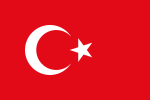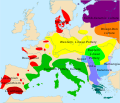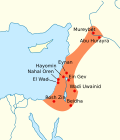adopted in situ by these hunter-gatherers and not spread by demic diffusion into the region. The Anatolian hunter-gatherers began farming around 8300... 7 KB (692 words) - 10:51, 31 January 2024 |
 | the "Anatolian hunter-gatherer (AHG) lineage later, suggested to around 25,000 years ago during the late LGM period. The Caucasus hunter-gatherers managed... 25 KB (2,411 words) - 22:17, 8 May 2024 |
Early European Farmers (redirect from Anatolian Neolithic Farmers) European Farmers can be modelled as Anatolian Neolithic Farmers with a minor contribution from Western Hunter-Gatherers (WHGs), with significant regional... 55 KB (6,208 words) - 13:27, 20 April 2024 |
 | Anatolia (redirect from Anatolian Peninsula) cultural exchange. Anatolian Neolithic farmers derived a significant portion of their ancestry from the Anatolian hunter-gatherers, suggesting that agriculture... 72 KB (7,273 words) - 01:54, 4 May 2024 |
 | Turkey (section Seljuk and Anatolian beyliks period) cultural exchange. Anatolian Neolithic farmers derived a significant portion of their ancestry from the Anatolian hunter-gatherers. Present-day Turkey... 324 KB (28,945 words) - 22:49, 13 May 2024 |
 | languages spoken by Eastern European hunter-gathers with influences from languages of northern Caucasus hunter-gatherers, in addition to a possible later... 54 KB (6,409 words) - 15:47, 17 April 2024 |
 | [citation needed] Anatolian Neolithic farmers derived a significant portion of their ancestry from the Anatolian hunter-gatherers (AHG), suggesting that... 79 KB (8,089 words) - 13:33, 8 May 2024 |
ancient DNA from Anatolia, specifically in the remains of an Anatolian hunter-gatherers dating from 13.642-13.073 BCE and belonging to mitochondrial haplogroup... 7 KB (635 words) - 00:28, 2 December 2023 |
 | Ancient North Eurasian (redirect from West Siberian hunter-gatherer) Eurasians are deeply related to Paleolithic and Mesolithic European hunter-gatherers, but also derive a small amount of their ancestry from a deep East... 103 KB (8,495 words) - 09:04, 10 May 2024 |
 | Women in prehistory (redirect from Woman the hunter) perspective of gendered roles in hunter-gatherer societies was of a model termed "Man the Hunter, Woman the Gatherer". Coined by anthropologists Richard... 17 KB (1,820 words) - 20:07, 6 May 2024 |
 | of hunter-gatherer ancestry. This hunter-gatherer ancestry was more similar to that of Eastern Hunter-Gatherers (EHGs) than Iberian hunter-gatherers, and... 30 KB (2,444 words) - 04:49, 3 April 2024 |
 | Turkish people (redirect from Anatolian Turks) inhabited by hunter-gatherers during the Paleolithic era, and was inhabited by various civilizations such as Hattians and ancient Anatolian peoples. After... 237 KB (24,478 words) - 22:26, 9 May 2024 |
uncovered in the Antalya Karain Cave. People of the Palaeolithic Age were hunter-gatherers who used stone and bone tools. The stone tools are displayed under... 19 KB (2,355 words) - 04:36, 24 April 2024 |
 | Indo-European migrations (section Anatolian hypothesis) European hunter-gatherers. Also, the Maykop (and other contemporary Caucasus samples), along with CHG from this date, had significant Anatolian Farmer ancestry... 270 KB (28,988 words) - 16:37, 27 April 2024 |
 | Natufian culture (category Hunter-gatherers of Asia) Contact between Natufians, other Neolithic Levantines, Caucasus hunter-gatherers (CHG), Anatolian and Iranian farmers is believed to have decreased genetic... 54 KB (5,755 words) - 13:39, 8 May 2024 |
 | Haplogroup X. She is phenotypically similar to the Anatolian early farmers and Caucasus Hunter-Gatherers. Her DNA revealed that she had black hair, brown... 17 KB (1,141 words) - 10:53, 27 March 2024 |
 | Neolithic Europe (redirect from Early Anatolian Farmers) Mesolithic hunter-gatherers, called the "Western Hunter-Gatherers" (WHG). Along with the Scandinavian Hunter-Gatherers (SHG) and Eastern Hunter-Gatherers (EHG)... 73 KB (6,393 words) - 01:23, 22 February 2024 |
 | Prehistoric Europe (redirect from Hunter-gatherers of Europe) Near Eastern farmers almost totally displaced the European native hunter-gatherers, and diffusionists, who claim that the process was slow enough to have... 81 KB (8,555 words) - 19:23, 11 April 2024 |











